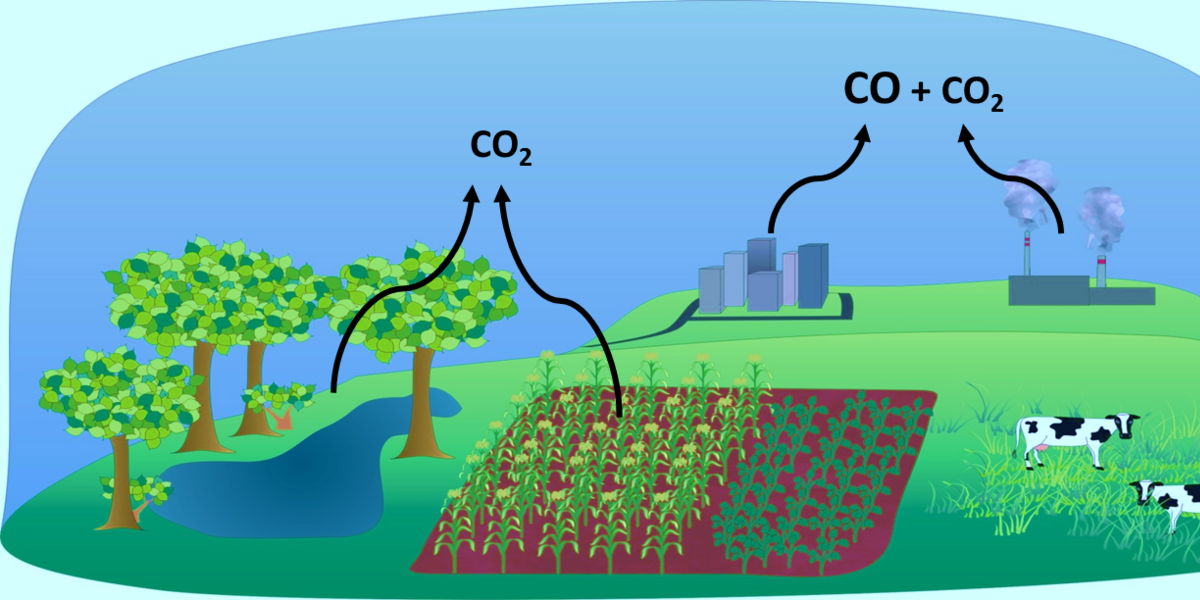The greenhouse gas carbon dioxide (CO2) is a product of human activities that use carbon-based fuels, such as home heating, cars, and manufacturing plants, to name a few. But CO2 also has many natural sources, such as soil, volcanoes and all living things that breathe. So a necessary question that should be asked by climate and citizen scientists alike is, “How do you know increases in CO2 are from human activity?”
There are two ways scientists can measure “human” sources of CO2 (let’s call this anthropogenic CO2) and “natural” sources of CO2 (let’s call this biogenic CO2). The first uses the radioactive isotope carbon-14 (or 14C). This is the isotope used in some cases to determine the age of objects (hence the term “radiocarbon dating”), and can also be used to determine the age of CO2 that is in the atmosphere. How is measuring the age of CO2 useful in determining what amount of CO2 is anthropogenic and how much is biogenic? Much of the anthropogenic CO2 is the result of fossil fuel burning, which, as the name suggests, is really, really, really, old (in the tens to hundreds of millions of years old). But much of the biogenic CO2 is the result of consumption or decomposition of modern organic matter made by plants and is relatively young (from days to hundreds of years old). So, if you measure the 14C of CO2, you can find out how old the CO2 in the sample is and calculate how much of it is anthropogenic CO2. The caveats to this approach are that it does not work when wood is the fuel, nor does it work for slash-and-burn farming practices. Also at the current state of technology, this analysis costs about $500 per sample.
An alternative strategy is to measure carbon monoxide (CO). CO is already an important molecule to atmospheric and climate scientists, because it affects levels of other greenhouse gases. But, CO can also be used as a tracer of anthropogenic CO2. How does this work? In an ideal world, the combustion of fuel would be 100% efficient, which means that when you rev the engine of your car, the exhaust would be exclusively CO2 and water. However, no combustion is 100% efficient, so a number of other combustion products arise from burning, CO among them. Thus, any time anthropogenic CO2 is produced, a little bit of CO will always come with it. In other words, if you were to see an increase in both CO2 and CO, then you know the increase in CO2 is from anthropogenic sources; but if you were to measure an increase in CO2 with no change in CO, then the increase is from biogenic sources. And best of all, it works with any source of carbon burning, including wood fuel and slash-and burn farming.
Here at Picarro, we are working together with scientists from the National Aeronautics and Space Administration (NASA), the National Oceanic and Atmospheric Administration (NOAA), the Chinese Meteorological Institute (CMA) and a number of other institutes to trail blaze the precise measurement of both CO2 and CO at the same time. With this data, scientists will be able to measure exactly how much anthropogenic CO2 is released to the atmosphere over time, and relate that information to broad climate factors such as temperature and precipitation. This will help scientists shed light on the relationship between human activities and the planet we live on, which in turn will enable a better prediction of future climate scenarios.

